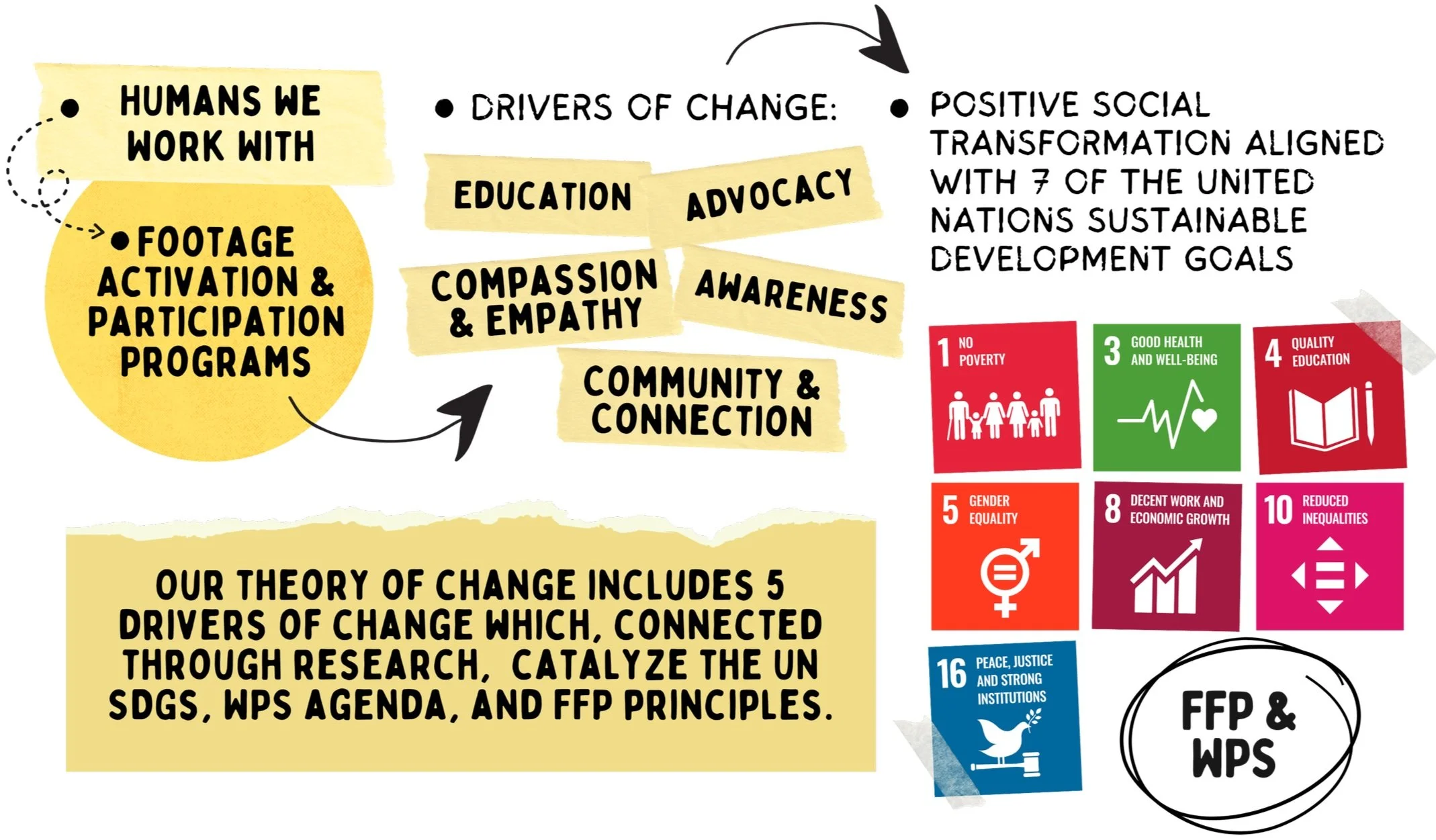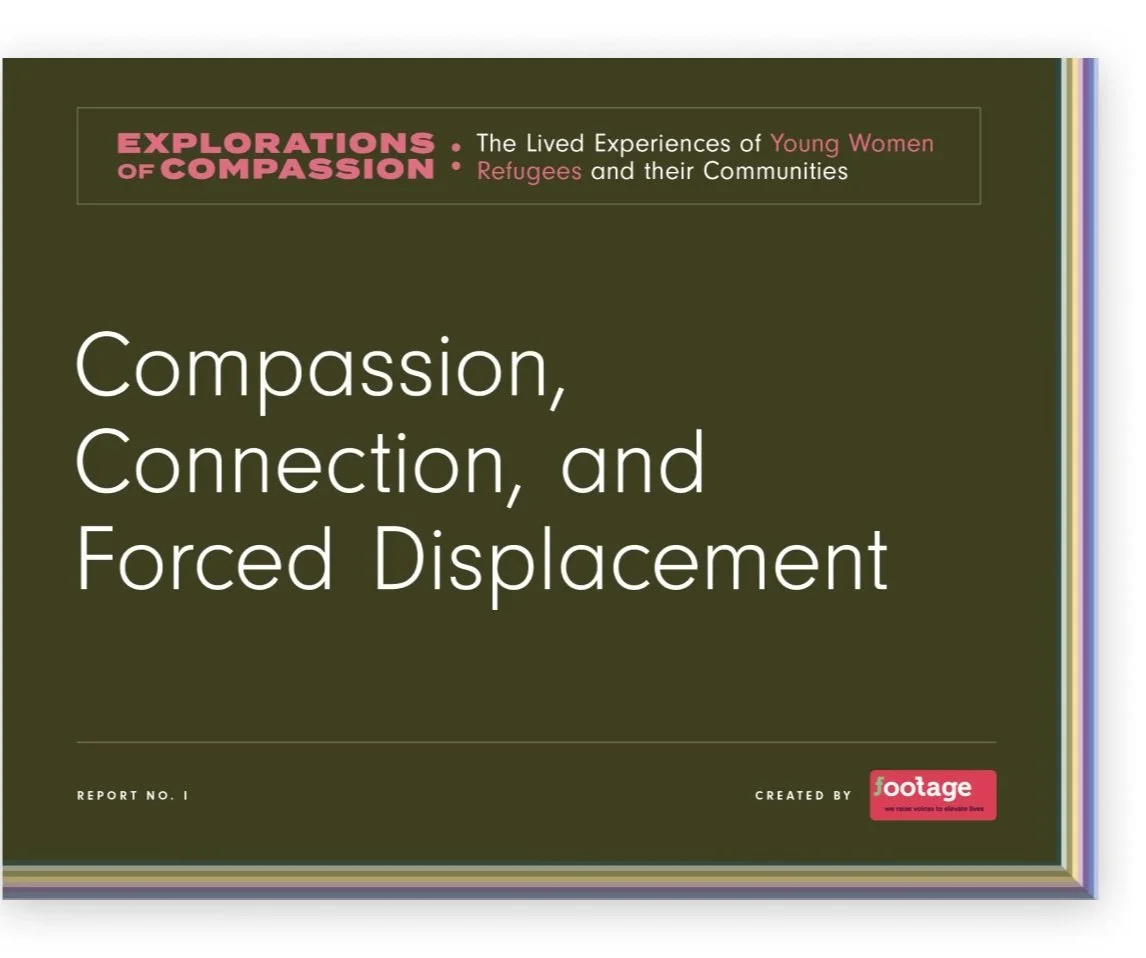At Footage, we envision a world where every person feels seen, heard, and worthy.
By addressing gender-based violence, forced displacement, and gender inequity through research, public diplomacy, dialogue and compassionate action, we create crisis-ready solutions that catalyze change. Thank you for your interest in learning about our approach to feminist research and diplomacy. We look forward to connecting with you.
A Footage Zine
Showcasing how, through our feminist research interventions, we can advance feminist foreign policies, together.
Our Theory of Change
Footage’s Model
Our model captures our intentional growth process, an organic and holistic approach, where every phase – from needs assessment to policy development – is informed by feminist principles. Our model isn’t linear but cyclical, with compassion, dialogue and diplomacy fueling through every stage. This model reaffirms our dedication to a world where every action, every dialogue, every policy seeks to advance gender equity, peace, and security defined as human security including wellbeing. We are committed to strategically advancing the UN Sustainable Development Goals (SDGs); Women, Peace and Security, and Feminist Foreign Policy principles.
Footage’s Methods
Read Our Refugee Report
Our refugee report shows prioritizing gender equality through compassionate leadership of women and girls crucial to achieving UN SDGs
-
This report is the first in a series on the role of compassion in the refugee crisis, by Footage Foundation, an international feminist organization established at Cambridge University by 5 women social science PhDs in 2009. Footage aims to empower marginalized young women and their communities through research, interventions, and advocacy, generating data that transforms lives and advances specific targets within the United Nations Sustainable Development Goal (SDGs). Since 2016 Footage has conducted compassion-based participatory multi-component interventions with refugee women across five European countries, generating rich qualitative and ethnographic data.
The purpose of the first report in the series is threefold: to provide an overview of Footage’s compassionate methods and interventions, to present a segment of the rigorous analysis of the ethnographic and qualitative data generated through these interventions, focusing specifically on connection and its relationship to compassion, and to offer a discussion and practical recommendations grounded in the voices and experiences of participants.
Weaving together narratives and voices, the findings of this report are structured around six interrelated subthemes that constitute connection: Relating and Relationships, Giving and Receiving, Trust, Belonging, Human Rights, and Identity. Furthermore, the report includes a dedicated section titled “Placing Connection,” which features three oral histories shared by women refugees. These personal accounts vividly illustrate how lived experiences cannot be separated from the sociocultural, political, and physical landscapes within which forcibly displaced individuals live and navigate. It is argued that policies and specific events not only shape the macro-level context in which participants’ narratives unfold, but also have long-term effects on their individual experiences and opportunities to cultivate connection.
In the discussion section of this report, the findings are conceptualized as “spaces of connection” that can either nurture or limit connection. Taking an holistic and relational perspective, the report asserts the importance of understanding these spaces as dynamic and subject to co-creation, shaping the experiences of forcibly displaced communities. Further, it is argued that connection and compassion are not simply “add-ons” to programming or interventions with women and girls, but central to advancing the lives and survival of women and girls, as well as to realizing many targets within the SDGs including within SDG 1 (No Poverty), SDG 3 (Good Health and Wellbeing), SDG 4 (Quality Education), and SDG 5 (Gender Equality).
As a broader vision, this report seeks to demonstrate the power of compassion and connection in the provision of services, including interventions that provide non-medicalized mental health support communicating compassion to refugees, and the potential that these services hold for the wellbeing of refugees, always with steadfast attention to refugee women. As a feminist organization, Footage prioritizes girls, women, and marginalized individuals. In the context of the refugee crisis, girls and women comprise more than half of the refugee population and face increased vulnerability during times of crisis and displacement.
The report concludes by emphasizing that connection is necessary for human life and wellbeing. The report calls for an approach to programming or interventions with women and girls that centers connection and compassion as it offers five recommendation areas including: The Power of Narrative, Methodological Recommendations, Educational Recommendations, Theoretical & Framework Considerations, and Aspirational: Honoring Young Women’s “Compassionate” Leadership. Actions range from using lived experiences and narratives in policy and decision making processes, to implementing trauma-informed arts-based methods, to ensuring ecological, feminist, and intersectional perspectives underpin, drive, and guide our interventions, to creating inclusive spaces for young women’s “compassionate” leadership.
Finally, this report underscores the relationship and significance of connection and compassion in the lives and wellbeing of young refugee women and their communities. It advances an understanding of connection and compassion as essential elements for the progress of women and girls, and aligns recommendations with the SDGs. The findings demonstrate the power of applied feminist approaches, research, and interventions to offer valuable insights into the lives of young women and the communities they belong to. These approaches involve addressing the specific needs of forcibly displaced women and girls, building social networks and connections, and fostering open and dynamic spaces that can be co-created, and reimagined to meet the diverse needs of those who are forcibly displaced. By incorporating the voices and agency of young women, Footage seeks to pave the way for new perspectives and possibilities in serving forcibly displaced populations.






